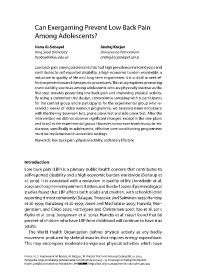Page 485 - Pedagoška vizija / A Pedagogical Vision
P. 485
Can Exergaming Prevent Low Back Pain
Among Adolescents?
Hana Al-Sobayel Andrej Kocjan
King Saud University Univerza na Primorskem
hsobayel@ksu.edu.sa andrej.kocjan@pef.upr.si
Low back pain among adolescentshashad high prevalence in recent yearsand
contributes to self-reported disability, a high economic burden worldwide, a
reduction in quality of life and long-term impairment. It is critical to seek ef-
fective prevention and therapeutic procedures. This study explores promoting
trunk stability exercises among adolescents who are physically inactive as the
first step towards preventing low back pain and improving physical activity.
By using a controlled trial design, convenience sampling with 8 participants
for the control group and 8 participants for the experimental group who re-
ceived 2 weeks of video workout programme, we assessed trunk endurance
with the Biering-Sørensen test, prone plank test and side plank test. After the
intervention we did not observe significant changes, except in the side plank
test (0.05) in the experimental group. However, to increase trunk muscular en-
durance, specifically in adolescents, effective core conditioning programmes
must be implemented in accessible settings.
Keywords: low back pain, physical activity, sedentary lifestyle
Introduction
Low back pain (LBP) is a primary public health concern that contributes to
self-reported disability and a high economic burden worldwide (Bontrup et
al. 2019). It is associated with a reduction in quality of life (Jonsdottir et al.
2019) and long-term impairment (Lötters and Burdorf 2006). Epidemiological
studies found that LBP affects both adults and children, with schoolchildren
reporting it most commonly (Balague, Troussier, and Salminen 1999; Harreby
et al. 1999; Gunzburg et al. 1999; Jones and Macfarlane 2005; Hurwitz, Mor-
genstern, and Chiao 2005; Hartvigsen and Christensen 2007; Yao et al. 2011;
Kędra et al. 2019; Joergensen et al. 2019). Harreby et al. (1997) found that 88
percent of children who have LBP from childhood will continue to have it as
adults.
The World Health Organization defines physical activity as any bodily
movement produced by skeletal muscles that requires energy expenditure.
This may encompass moderate-to-vigorous physical activities which have
Krmac, N.,S.Hudovernik, M. Rodela,M.Mezgec, M. RadetićPaićinM. Kukanja Gabrijelčič, ur. 2024.
Pedagoška vizija: premikanje izobraževanja od tradicije do inovacij – 50 let razvoja na Pedagoški fakulteti.
Koper: Založba Univerze na Primorskem. https://doi.org/10.26493/978-961-293-358-6.485-495

